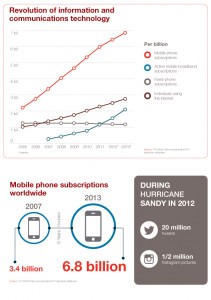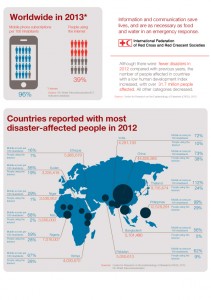Lack of access to information and technology is having a major impact on people’s ability to prepare for, survive and recover from disasters, says the 2013 World Disasters Report launched today in Southeast Asia by the Singapore Red Cross and the International Federation of Red Cross and Red Crescent Societies (IFRC).
This year’s World Disasters Report focuses on technology and the future of humanitarian action. Written by over 40 humanitarians and academics, the report emphasizes that during the first critical hours after an emergency, most lives saved are actually saved by local people. Yet many of these first responders don’t have access to basic life-saving information and tools, such as early warning systems and basic connectivity and network infrastructure.
While “new technologies are greatly increasing disaster-affected communities’ capacity for self-help”, the report acknowledges that access to these technologies is “deeply unequal”. This inequality, called the “digital divide” throughout the report, is prominent in the most disaster-prone countries around the world.
“Although the overall number of people affected by disasters decreased in 2012, the number of people affected in the poorest countries increased, with over 31.7 million people affected,” states Patrick Vinck of the Harvard Humanitarian Initiative and editor of the 2013 World Disasters Report. “They are also often the ones with the least access to technology.”
The report goes on to caution that as humanitarian agencies increasingly turn to new technologies as a source of information about disaster-affected communities’ needs, they run the risk of only listening to those who are connected, and excluding those who are not.
Bekele Geleta, Secretary General of the IFRC, explains, “We hope that governments and affected people in disaster-prone countries can take advantage of innovations like weather prediction software, satellite imagery and mass alert systems, increasing their resilience to disasters and their ability to recover quickly when they do happen. Typhoon Bopha affected 6.3 million people in the Philippines, and thousands of lives were saved because 99 per cent of the population have access to a mobile phone and could receive early warnings and information on staying safe.”
The report urges the private sector, humanitarian organisations, governments and local communities to partner together to overcome these inequalities in access to technology for both populations and responders.
“There are great examples of what can happen when technology experts and humanitarians put their heads together,” states Ed Happ, the Global Chief Information Officer of the IFRC. Happ adds, “The IFRC and the telecommunications company Trilogy developed the TERA SMS system, which has allowed 3 million people in Haiti to receive hurricane warnings and disease prevention advice. We recently set it up in Sierra Leone, and our ambition is to launch TERA in 40 countries. But we can’t do it alone, we need the private and public sectors to work with us.”
Geleta adds, “The 2013 World Disasters Report examines the potential of technology to improve humanitarian operations and increase people’s resilience to disasters. It also looks at the risks and unintended consequences of this influx of technology and provides recommendations on how to maximize the opportunities, while minimising the risks. Ultimately what matters is not technology, but how it is used to improve peoples’ lives.”
2012 disaster data: Fewer deaths from disasters than in the last 10 years
The Report also features its annual summary of disaster information. 2012 saw the lowest number of deaths and people affected by disasters in the last 10 years. Deaths from disasters in 2012 were 90 per cent below the average for the decade. The number of disaster events is also amongst the lowest of the decade. However, 2012 was still recorded as the fifth most expensive of the last 10 years in terms of disaster costs.
In all, there were 552 disaster events costing just under US$ 158 billion. The most expensive disaster was Hurricane Sandy, which cost US$ 50 billion and the deadliest was Typhoon Bopha in the Philippines, which killed 1,901. Floods accounted for 53 per cent of the 139 million affected by disasters in 2012, with the most severe taking place in China in April and June.
Notes:
- A global launch of the report is taking place today at Harvard University in the United States where the IFRC, Harvard Humanitarian Initiative and the American Red Cross will host two launch sessions – a web seminar for a global audience and a panel discussion for a live audience. The launch sessions will highlight the key findings from the report and how governments, humanitarian actors, private sector and academia are currently using and advancing technology to address global problems.
- The World Disasters Report is in its 21st issue and over the past two decades has covered topics such as forced migration, neglected crises, public health, HIV and AIDS and urban risk.
[Please click on image for full view]
Chairmans Speech for World Disaster Report 2013 Launch



